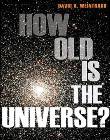A talk called “How old is the Milky Way and how do we know it?” will be presented by Dr. Robert Benjamin, associate professor of physics, on Fri., Nov. 30, at 8 p.m. in Upham 140. It’s the penultimate entry in the Observatory Lecture Series, which has the theme “The Age of Life, the Universe and Everything” and is meant to explain “how biologists, geologists and astrophysicists answer questions about the age of the universe and its contents.” The series is sponsored by the UW-Whitewater Science Outreach Office and the College of Letters and Sciences. The talks are free and open to all! Following the talk there may be a viewing session at the observatory, weather permitting.
Lecture abstract:
Every star that you can see in the sky is part of our own Milky Way Galaxy. Although it common to think of the sky as timeless, stars are constantly forming and dying over the billions of years of years of the Sun’s past and future existence. In this lecture, I will describe how we determine the age of the Milky Way and other galaxies like the Milky Way. The age of the Milky Way comes down to determining the ages of the oldest clusters of stars, and of the oldest individual stars. The oldest stars indicate that the Milky Way started to form approximately 13 billion years ago, not very long after the Big Bang (13.7 billion years ago). But there is a great deal of evidence that the Milky Way formed over a rather long period, with the disk of the Galaxy forming significantly later than the first stars. I will contrast this with the picture of we have of the formation of other galaxies. Modern telescopes are now detecting galaxies so far away that we are seeing what galaxies look like when the light left the galaxy billions of years ago. Understanding the rate at which the different parts of galaxies have formed over the history of the universe is one of the frontiers of modern astrophysics.
 Like to learn more? Andersen Library can help! Search HALCat to find books like How old is the universe? (3rd-Floor Main Collection, QB501 .W45 2011). Search the article databases to find articles such as “Astrophysics: Young dwarfs date an old halo” (Nature, 2012, vol.486:no.7401, pp.38-40), “Milky Way faces midlife crisis” (New Scientist, 2011, vol.210:no.2814, p.8), and “Age Estimates of Globular Clusters in the Milky Way: Constraints on Cosmology” (Science, 2003, vol.299, pp.65-69).
Like to learn more? Andersen Library can help! Search HALCat to find books like How old is the universe? (3rd-Floor Main Collection, QB501 .W45 2011). Search the article databases to find articles such as “Astrophysics: Young dwarfs date an old halo” (Nature, 2012, vol.486:no.7401, pp.38-40), “Milky Way faces midlife crisis” (New Scientist, 2011, vol.210:no.2814, p.8), and “Age Estimates of Globular Clusters in the Milky Way: Constraints on Cosmology” (Science, 2003, vol.299, pp.65-69).
Please ask a librarian if you’d appreciate assistance with finding materials.
